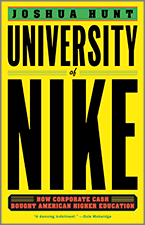
Joshua Hunt.
Melville House, 2018; 304 pp;
ISBN: 978-1-612-19691-6.
By James Compton
Beware of corporations bearing gifts. It’s most likely a Faustian bargain. That’s the core takeaway from Joshua Hunt’s University of Nike: How Corporate Cash Bought American Higher Education. Hunt, a former foreign correspondent with Reuters, tells the tale of how the University of Oregon tied, not only its name and athletics department, but eventually it’s entire funding model, to what he calls the “politics of shoe money.”
The journey from mid-sized public university to global corporate brand extension begins in 1990. That’s the year Oregon anti-tax activists succeeded in passing Ballot Measure 5, a major revamping of the state’s property tax laws that favoured wealthy property and business owners. The measure was part of a wave of neoliberal activism in the 80s and 90s. In the measure’s wake followed a series of ballot initiatives “aimed at slashing property taxes, hamstringing labor unions, reducing pensions for public employees, and linking teacher pay to performance.” It was a first, writes Hunt, because at that time no other state in America “was seeking to significantly reduce its level of financial support for colleges and universities.” In 1989 the University of Oregon was receiving nearly half of its funding from “state coffers.” However, after Ballot Measure 5 change came fast. Funding had slipped enough that then University President Myles Brand began asking faculty to speak at high schools — metaphorically cap in hand — to recruit new students when they traveled out of state.
By 1993 the painful effects of Ballot Measure 5 were sinking in for the University of Oregon. That same year NBA superstar Michael Jordan announced his retirement at age 30. His departure meant Nike was losing the celebrity brand that had help catapult the company into a global shoe apparel giant. It was in this moment that a confluence of interests developed between the University and Oregon entrepreneur Phil Knight’s shoe and apparel empire. Nike was searching for a new promotional vehicle and the cash-strapped university was on the hunt for new revenue streams. This was the beginning of the Faustian bargain that new university President Dave Frohnmayer sealed with Knight.
The relationship started small, with Knight buying his own suite at Eugene’s Autzen Stadim in 1991. The company’s first “gift” came in 1994, $27.4 million to renovate the U of O’s library, which was re-named after the Nike CEO. Hunt writes that Knight “treated his philanthropic endeavors like he treated any other business investment. Rather than paying for building projects outright, he invested in them.” When the school’s athletic staff told Knight they needed an indoor practice facility to attract top high school talent, he ponied up half of the required $16 million for the new 117-thousand-square-foot Moshofsky Center, retaining the naming rights. The university was left “to raise the remainder of the funds from other private donors, or through tuition increases or bond initiatives.” The so-called “Nike Way” set the pattern for all future investments and allowed for the circumvention of many of the normal processes expected of public universities for such projects. Knight would start a limited liability shell company, lease the land for the building from the university, pay for the design and construction of the project and then hand the finished product over to the school. As a private venture, the university was relieved of the need for a public bidding process and negotiations with union labour. There was also no requirement to disclose records to the public.
Other components of the Nike way would follow. Sales reps were sent directly to coaches who cut their own personally lucrative deals with Nike for sports apparel and salary sweeteners. Jerseys and shoes would be given free to athletes who acted as “walking billboards” for the Nike brand.
The story of shoe money unravels slowly, with many side-bar tales about the various presidents and coaches who found themselves ensnared in the politics of “sneaker money.” This may test the reader, but those with patience will learn a great deal about the thin line between corporate philanthropy and self-dealing hucksterism. Above all, Hunt wants his readers to know the hidden truth behind college sports is that they don’t make money — on the contrary they rely on public subsidies that serve private self interest.
__________________________________
James Compton is an Associate Professor in the Faculty of Information & Media Studies at Western University and CAUT’s past president.